
A damaged cv joint could negatively affect a transmission in certain circumstances.
A CV axle, made up of two CV joints and an axle shaft, is what transfers power from the vehicle's transmission to the wheels.
CV joints are parts that often fail and will result in a bad CV axle vibration which will put undue stress and vibration, which could cause problems with the transmission.
A telltale clunking sound accompanying low-speed driving and excessive vibrations suggests a CV joint issue.
The problem is often remedied by a reasonably simple repair known as a CV axle replacement.
Below we'll discuss the purpose of CV joints, the symptoms of bad ones, and how to test them.
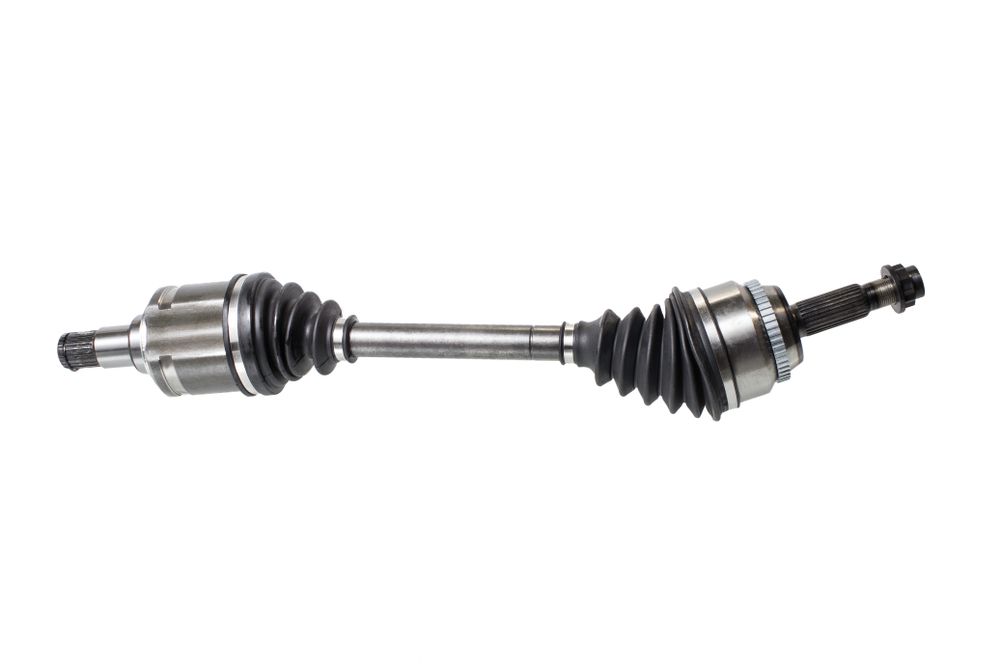 CV axle (2 CV joints at each end connected by a CV axle.)
CV axle (2 CV joints at each end connected by a CV axle.)
What Is a CV Joint? What Purpose Does a CV Joint Serve?
All front-wheel drive vehicles have CV joints on either end of the CV axle shafts.
The inner CV joints attach the axle shaft to the transmission, whereas the outer ones connect the CV axle to the wheels.
A CV axle shaft articulates with bumps and wheel turns to provide consistent power to the wheels from the transmission and lets the vehicle's suspension provide a smooth ride.
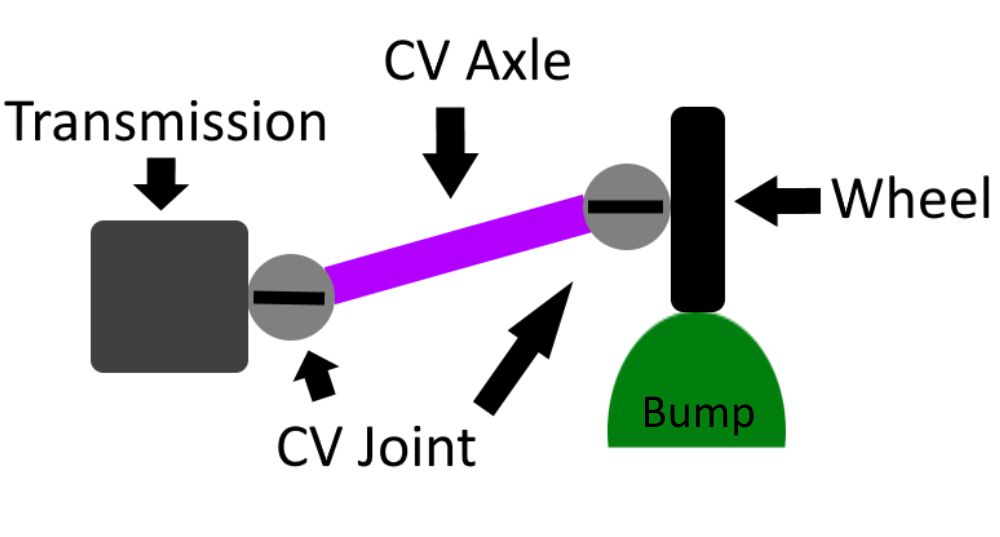 CV joints articulate to let the vehicle's tires remain perpendicular to the road surface over bumps while allowing for a smooth ride due to the vehicle's suspension.
CV joints articulate to let the vehicle's tires remain perpendicular to the road surface over bumps while allowing for a smooth ride due to the vehicle's suspension.
But it isn't just front-wheel drives that have them.
Four-wheel drive vehicles also have CV axles to deliver power from the transfer case to the front wheels.
In vehicles like a Porsche 911 with a rear transaxle, which is a combination between a transmission and an axle, there are CV axles from the transaxle to the rear wheels.
The joints consistently transfer torque from the transmission to the wheels while dealing with the suspension's up-down motion.
If you have a front-wheel drive car, the CV joints supply torque to the front wheels when turning.
Generally speaking, there are two types of CV joints — a ball and a tripod.
Ball-type CV joints are found on the outer side of the drive shaft in front-wheel drive cars, while the tripod style is on the inside.
No matter the type, they're essentially an assembly of cages and bearings, permitting power transmission and axle rotation at various angles.
Specifically, CV joints include:
- Balls
- Cage
- Inner raceway
- Housing covered by CV boots
- Lubricating axle grease
What Does CV Stand For?
CV stands for Constant Velocity.
It's an apt name since properly functioning constant velocity joints and constant velocity axles keep torque delivery constant.
What Is the Difference Between a CV Joint and a CV Axle?
Sometimes called half-shafts, CV axles are found in front-wheel drive cars.
They transfer the engine's power to both drive-wheels from the transaxle.
You might find CV axles in a few late-model vehicles with separate rear suspension and a few all-wheel or four-wheel models.
CV joints are components of the CV axle — although many people confuse them, so you aren't alone.
The joints are the elements that allow the axle to transfer the power at a constant speed while dealing with ever-changing travel conditions.
Without CV joints, the axle would seize or break whenever the car hits a bump or turns.
For best performance, you need constant velocity joints in great condition.
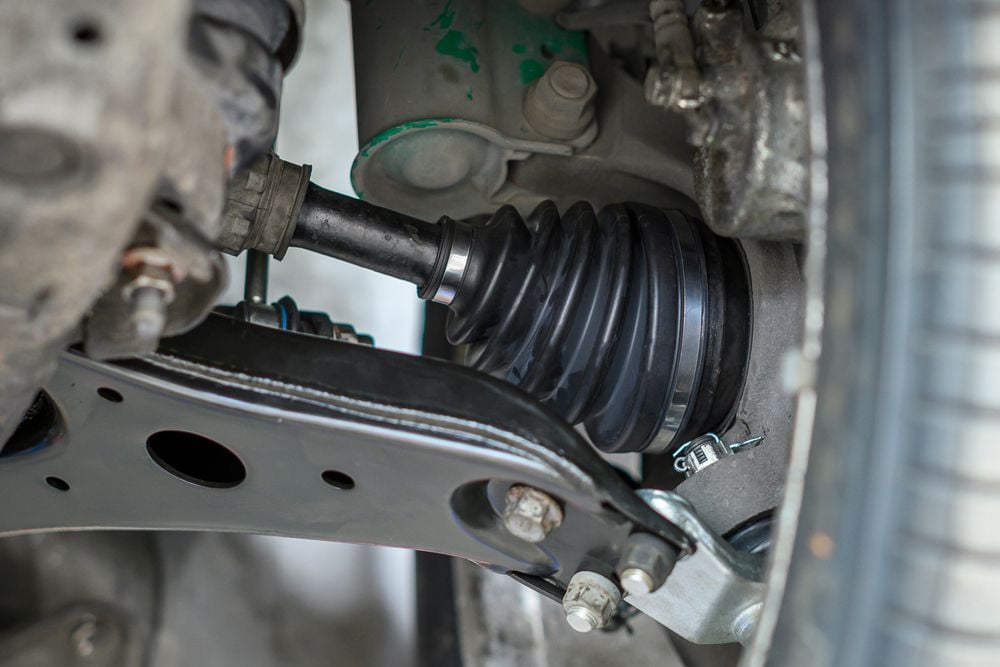 CV joint connected to the vehicle's wheel
CV joint connected to the vehicle's wheel
Is the CV Axle Connected to Transmission?
The inner CV joints connect the CV axle (i.e., half shaft or drive shaft) to the transmission, either manual or automatic transmissions, allowing correct torque distribution and vehicle performance.
What are The Different Symptoms of a Bad CV Joint? Why Do They Happen?
The easiest way to confirm you have a bad CV joint is to listen to the sounds emanating from your vehicle.
Typically, CV joint failure symptoms include:
- Clunking sound as the transmission engages (although this is also a common sign of outer CV joint failure)
- Light thump when braking suddenly
- Clunking sound at 20 MPH
- No noticeable change in CV joint sound when changing the wheel angle
- Cracking or splitting around the rubber boot
- If a CV boot cracks, it will lead to premature CV joint failure because it allows the CV joint grease to escape while allowing dirt and dust to enter
- Excess grease on transmission, suspension, or cross-member
- The front tires won't point the same way because one CV axle is disconnected from the wheel.
The easiest way to tell which CV joint is bad (i.e., inner or outer) is to turn in a relatively tight circle.
If the constant velocity joint sounds grow louder, quieter, or change pitch when turning in either direction, it's an outer joint problem.
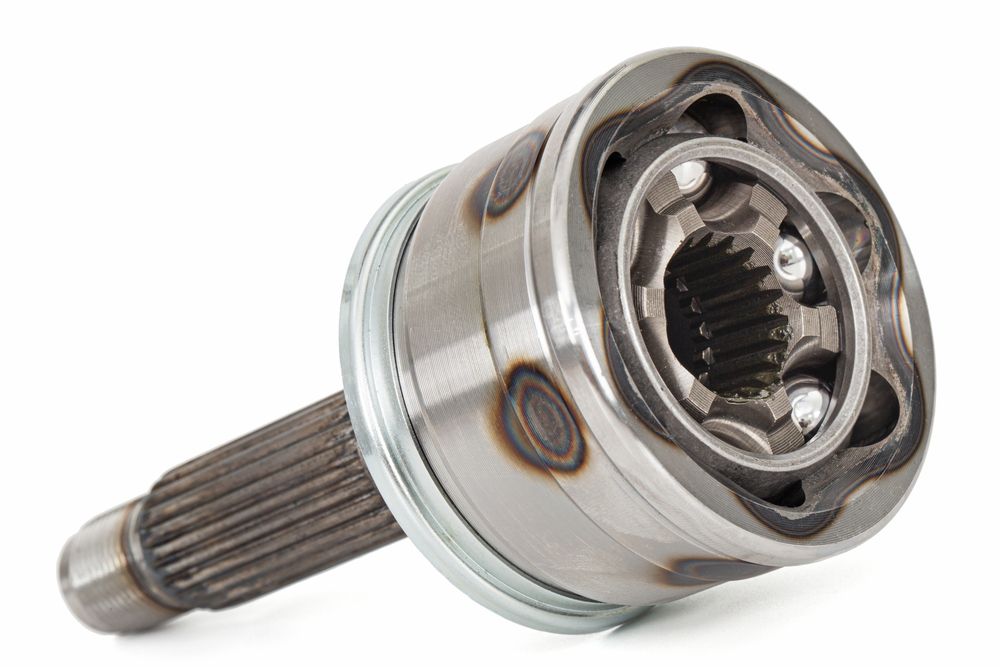 Inside a CV joint shows the articulating mechanism.
Inside a CV joint shows the articulating mechanism.
Can a Bad CV Axle Cause Shaking?
A faulty CV joint could cause excessive drivetrain shaking or vibration.
Can Bad CV Joint Cause Transmission Problems?
When a CV joint goes bad, it can negatively impact the transmission.
After all, it's the component allowing optimal torque through the drive shafts.
Bad or worn-out cv joints can mess up your transmission by creating vibration.
Because the cv axle is connected directly to the transmission, a bad cv axle vibration will cause a vibration that will run throughout the transmission's internals, possibly causing damage.
However, it isn't the only factor that can cause such problems.
If you experience any undesirable symptoms, talk to your local mechanic as they can determine the true root cause and conduct the appropriate repairs.
Can a Bad Axle Cause Shifting Problems?
A bad axle often causes shifting problems.
As mentioned, a bad cv axle will stress your transmission's internal parts from vibration, leading to premature transmission failure and shifting problems.
Other things can cause shifting problems, like a clogged transmission fluid filter or a low transmission fluid level caused by leaking transmission fluid.
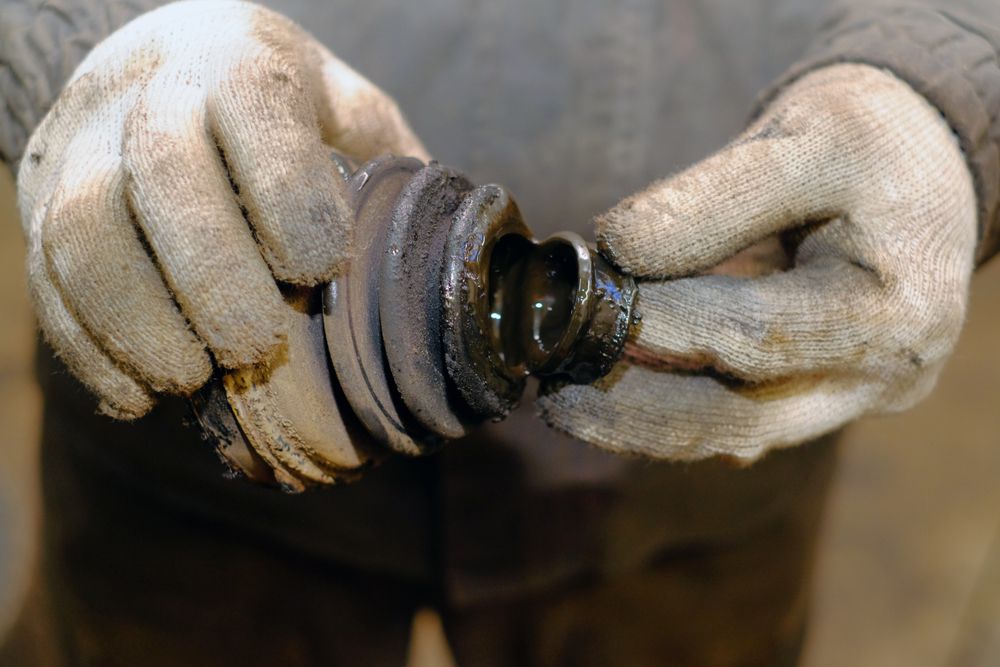 Torn CV joint boot.
Torn CV joint boot.
Can CV Joint Cause Transmission to Slip?
Transmission slippage is one of the most common issues arising from a bad constant velocity joint.
Typically, adequate joint lubrication solves this problem.
But if not, it will need replacing.
Can Transmission Fluid Leak from CV Axle?
One of the most noticeable signs of a CV axle problem is a pool of fluid underneath your vehicle.
Transmission fluid or oil can leak from the axle if the shaft seal fails.
Take your car to the repair shop as soon as you notice this problem.
A low-fluid transmission can overheat incredibly quickly.
Can a Bad CV Joint Affect Gas Mileage?
A bad CV joint probably won't significantly affect gas mileage.
Some argue that bad CV joints reduce the overall efficiency of your drivetrain, negatively affecting gas mileage.
Others claim that bad constant velocity joints won't impact your fuel consumption; they'll just make a terrible clanking noise and eventually break.
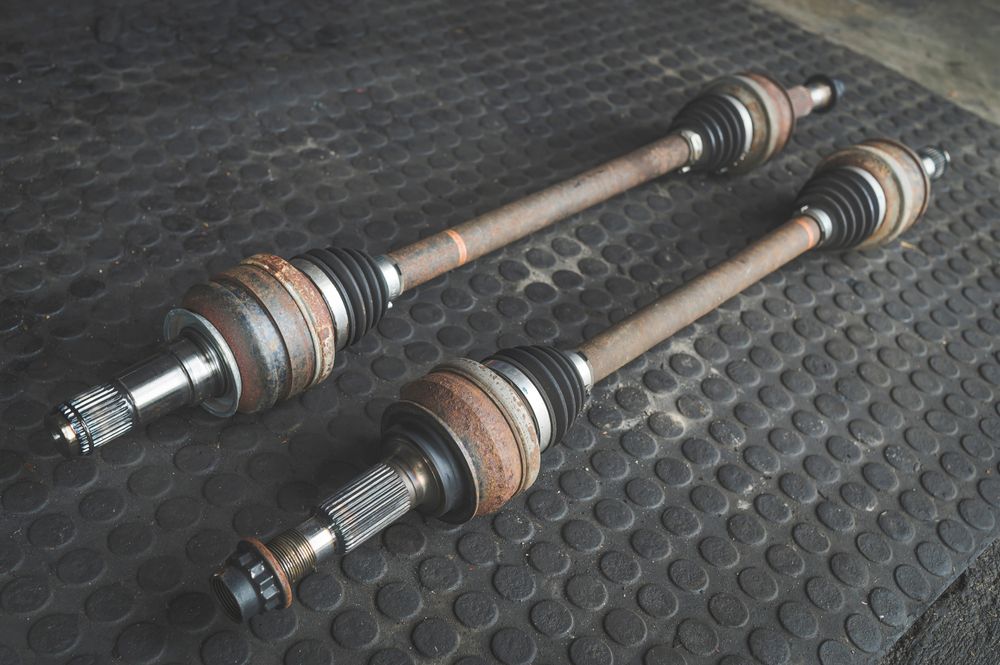 Two CV axles on the shop floor.
Two CV axles on the shop floor.
What Happens If CV Joints Fail While Driving?
A CV joint failure while driving could lead to a dangerous situation. If the joint blows apart completely, the wheel will no longer receive power, making power distribution between the tires uneven. The wheel will also become unstable, significantly affecting the vehicle's handling.
How to Test CV Joints
To know if your CV joint needs replacing, you must conduct a thorough test.
Looking (or listening) for the signs we discussed earlier is the first step, but you can't make a proper diagnosis without concrete evidence.
Thankfully, testing CV joints is simple enough with the right equipment.
Follow the steps below to test constant velocity joints:
- Look at the rubber boots —A damaged cv joint boot can lead to prematurely worn cv joints because dirt and debris can enter the joint while the CV joint grease is allowed to escape.
- Accelerate and decelerate quickly yet smoothly —While driving, take note of any shuddering or lurching by the axles and listen for a "clunk" sound.
- Turn in a circle —Rotate the steering wheel completely to one side and accelerate gently, driving in a relatively tight circle. Repeat in the opposite direction. If you hear any snapping, clicking, or popping while turning, it's likely a faulty CV joint.
- Jack the vehicle —After that, set your vehicle on jack stands along its frame, ensuring they won't interfere with the axle movement. Put one hand on either side of the joint and twist the axle in opposite directions. You need to replace the CV joint if it makes clicking noises or feels overly sloppy.
If the unpleasant noises changed pitch or volume while turning in a tight circle, you're safe to assume it's an outer CV joint problem.
If not, confirm it's an inner CV joint problem by performing these steps:
- Shift into drive with your foot on the brake —Listen out for the telltale clunking sound as the transmission kicks in. Depending on the severity, you can tell where the problem lies by paying close attention.
- Accelerate to 10 MPH and maintain —Push the accelerate, so the car quickly boosts to 20 MPH and listen for clunking. Repeat the process from 20 MPH to 30 MPH and 30 MPH to 40 MPH.
- Brake suddenly —You might hear a dull thud when emergency braking, especially from faster speeds.
- Shift into reverse and pump the throttle —Jab the accelerator several times, listening for a similar but softer clunk. Hear it? That's a bad inner CV joint.
- Manually check the CV joint —Finally, jack the car and visually inspect the joint as before to confirm your findings.
 Broken wheel bearing in the mechanics hand.
Broken wheel bearing in the mechanics hand.
How Can You Tell the Difference Between Bad CV Joints and Bad Wheel
Bearings?
It's all about the sounds.
Grinding, rumbling, or growling noises emanating from the faulty
wheel, particularly at low speeds, indicates a bad wheel bearing.
Although, the sounds might be accompanied by a series of symptoms,
including:
Clicking noises when turning, however, indicate a bad CV joint.
The location of the sounds plays a major role too.
If you hear it from inside the vehicle, it's a bad wheel bearing, while
outside the vehicle indicates a faulty CV joint.
How Much Does It Cost to Fix a CV Joint?
A CV joint replacement can cost anywhere from $150 to $850.
Your car type, the mechanic, and the cost of the part influence the amount you pay.
Conclusion
Transmission problems are undoubtedly a reason to worry, and a bad CV joint could be the culprit.
Excessive vibration caused by a faulty cv shaft or damaged cv joints could lead to transmission problems because the CV axle is directly connected to the transmission, so any vibration could travel into the transmission and damage its internals.
If you notice excessive vibration, clicking noises, or grinding noise coming from the car's front end, you should have it looked at by a professional mechanic.